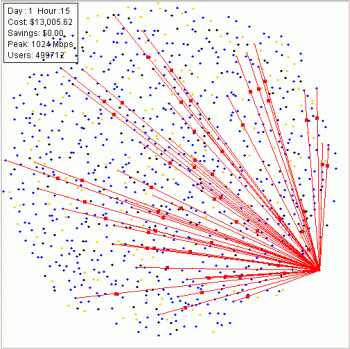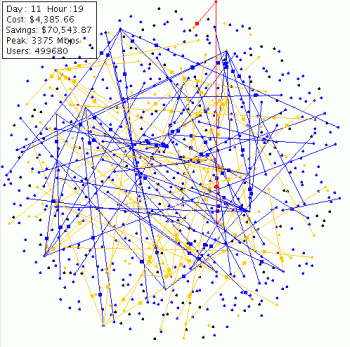Beyond BitTorrent - Swarming-Based Content Delivery: SwarmStreaming
When it comes to distribute very large audio or video files nothing has been able to surpass so far the efficiency of BitTorrent streams.

Client-server content-delivery
BitTorrent has been able to prove to the many who have tried it out the effective value of swarming-based content delivery versus more traditional client-server approaches.
But if people are impressed by Bittorrent, they're going to be absolutely blown away by swarmstreaming.
Swarmstreaming is a technology designed to provide lightning-fast downloads of web content and multimedia without any special server software or special plugins/files. The creation of Justin Chapweske, swarmstreaming is a very promising technology that allows fast and efficient distribution of content and large media files, while saving and optimizing bandwidth consumption for content hosts.

Swarming content delivery
The technology improves swarming by ensuring that the bytes that the user wants next are scheduled to be received next. So if they're playing back a video file, the bytes from the front of the file will be received first. If the user (or application) skips forward to the middle of the file, the bytes at the middle of the file will be prioritized.
Thus, unlike first generation swarming systems like Swarmcast or Bittorrent, you don't have to wait for the entire file to download to do something useful with it!.
The only thing that BitTorrent has which SwarmStream doesn't is its open source nature.
Swarmcast, the technology than enables swarmstreaming will be completely free and provides all of the functionality mentioned above since it embeds the full SwarmStream engine. Swarmcast version 3 should in fact become available very soon.
Any user, blogger, or web server administrator that wants to use swarmstreaming doesn't have to pay a dime for it nor do they have to modify their web pages or generate .torrent files in order to swarm-enable their content.
Here some of the specs that left me staring:
- WAN Acceleration - 900% faster or more than FTP and NFS, especially over long distance or congested networks.
- Parallel Streaming Downloads - Retrieve data from multiple sources and play it or process it while it's still downloading.
- Grid Acceleration - Swarming algorithms retrieve cached copies of files from nearby nodes via optimal network routes.
- Reliable Resume - Resume transfers from previous sessions.
- Integrity Verification/Corruption Repair - Patent-pending cryptographic algorithms automatically identify and repair any data corruption that could occur in transit.
- 128 bit SSL/TLS Encryption - Industry standard encrypted data transfer.
- Firewall Friendly - Uses the standard HTTP protocol, so no "punching holes" or bypassing firewall rules is required.
- Small and Embeddable - 100% Javaâ„¢ libraries allow you include only the features you need directly into your application.
There is only a 25K (USD $) SwarmStream SDK package that bundles together a day of training, support, and a whole suite of supporting technologies for application developers that want to add swarming capabilities to their own applications.
The #1 priority at Swarmcast right now is on getting the technology embedded in other people's apps, with the Java community being the first target.
With swarming-based content delivery mechanisms, service providers can gain tight control over costs while still providing extremely high peak throughput.
More info: http://onionnetworks.com/

blog comments powered by Disqus